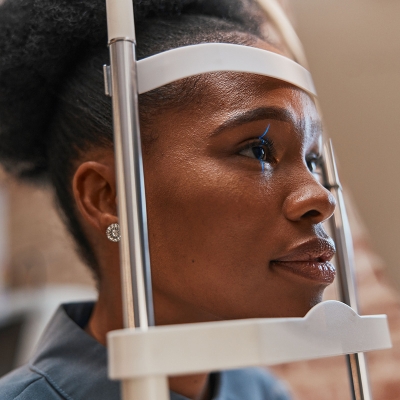5 ways to help protect eyes from diabetic macular edema
Tens of thousands of people with diabetes may be affected by this eye condition. Here’s what they might do for their vision.

People with diabetes may develop certain conditions that could affect their vision. One of them may be diabetic macular edema, or DME for short. It affects more than 75,000 people in the United States every year.1
When someone has DME, they experience swelling in their macula, the most sensitive part of the retina, which is responsible for our sharpest vision. The retina is a light-sensitive tissue located at the back of the eye.2 The swelling may occur when blood vessels in the retina leak fluid.
“The macula is one of the most important parts of eye, containing a high concentration of photoreceptors, which allow us to see things in fine detail,” says Besty Jacob, O.D., an optometrist with Family Eye Care in Coral Springs, Florida. (Photoreceptors are special cells that detect light in the retina.) If too much fluid leaks out, it may result in vision issues and may damage these special cells, says Dr. Jacob.
Fortunately, there may be ways to protect the eyes from DME, along with treatments that may reverse damage, especially if treated early. Here’s what might happen when DME occurs — and how it may be treated. Plus, learn 5 strategies patients may take to slow its progression.
Stay on top of your eye health with an in-network provider. Search for an eye care provider now.
What may happen when someone has diabetic macular edema?
If someone with diabetes does not manage their blood sugar (glucose) consistently, the blood vessels in their eyes may become damaged. Over time, this may cause diabetic retinopathy, which may progress to include DME.
People with symptoms of this eye condition may experience these symptoms, according to Dr. Jacob:
- Colors appear dull or muted
- Blurry or double vision
- Loss of central vision
- Seeing spots, circles or wavy lines across vision (floaters)
- Trouble seeing in bright light
Vision loss from DME may depend on several factors, says Dr. Jacob. “The longer macular edema remains untreated, the higher the risk of permanent vision loss and the extent of fluid buildup in the macula that significantly impacts loss of vision.”
5 ways to help protect the eyes from diabetic macular edema
Not all people with diabetes will develop DME. Luckily, there are a variety of things that may be done to keep a person’s eyes healthy. A person may want to try these 5 protective tips:
1. Keep up with eye care provider visits
The Centers for Disease Control and Prevention (CDC) reports that 60% of people with diabetes do not get annual eye exams.3 It is recommended that all people, especially those with conditions such as diabetes, receive an annual eye examination with dilation from an eye care professional to:
- Evaluate their vision
- Evaluate their eyes for possible eye diseases or conditions (many eye conditions may not have symptoms that a person would notice until the disease is severe)
That’s according to Catherine Heyman, O.D., F.A.A.O., the founding dean and an associate professor at High Point University’s School of Optometry in High Point, North Carolina. “For example, dilated eye exams can detect early signs of diabetic retinopathy and diabetic macular edema, allowing for timely treatment,” she adds. (Diabetic retinopathy is an eye condition that may cause vision loss and blindness in people with diabetes; it occurs prior to DME.)
2. Maintain healthy blood sugar levels
This may be a no-brainer when it comes to diabetes, but keeping blood sugar levels within a healthy range may help prevent diabetic retinopathy and DME, says Dr. Heyman. “An A1C level below 7 is the target level for prevention,” she adds. (A1C is an average measure of blood sugar over the past 3 months.)
3. Stay physically active
“Regular exercise improves blood circulation, aids in blood sugar control and reduces inflammation, all of which protect blood vessels in the retina,” says Dr. Heyman.
Dr. Jacob recommends mild to moderate exercise for patients with DME. According to the CDC, adults need at least 150 minutes of moderate-intensity physical activity a week, along with 2 days of muscle-strengthening activity each week. This could consist of activities like brisk walking and lifting weights. The physical activity may be broken down into 30 minutes a day, 5 days a week.3
4. Consider not smoking
Smoking may damage cells and cause inflammation in the body, which can lead to blood vessel damage in the eyes, notes Dr. Heyman. So, doing the opposite may protect someone from developing diabetic retinopathy and DME. Or it may at least slow the progression of these conditions in a person who already has them, she adds.
5. Pay attention to blood pressure and cholesterol levels
“Managing high blood pressure, also known as hypertension, and cholesterol levels can reduce the risk of severe retinal complications,” says Dr. Heyman. How? High blood pressure may damage blood vessels, including those in the retina. So, controlling it may reduce the risk of this damage.
When it comes to cholesterol, elevated levels may lead to the formation of hard deposits in the retina. “Watching cholesterol levels reduces the likelihood of these deposits and associated retinal damage,” notes Dr. Heyman.
How might an eye care provider treat diabetic macular edema?
DME is treatable, and if caught early it may be reversible. The most common treatment for DME may be by using medication, notes Dr. Heyman. Here are some common potential options:
- Anti-vascular endothelial growth factor (VEGF) injections. These injections are the most common treatment and go directly into the eyes. “These treatments have shown effectiveness in reducing macular edema and improving visual acuity,” Dr. Heyman explains.
- Laser treatments. Less commonly, specific types of laser treatments may be used, if the injections haven’t worked.
- Corticosteroid injections. These are steroid injections and may also be used, especially when patients don’t respond well to anti-VEGF therapy, however this is very infrequent, notes Dr. Heyman.
If an eye care provider finds DME early, they may start one of these treatments right away, says Dr. Jacob. “The nice thing about DME is it’s treatable,” he says. “The most important thing is to catch it early, because you can reverse minor damage at that point, which is a win-win for everyone involved.”
Looking for a new eye care provider? Search the UnitedHealthcare Vision Network now.
Sources:
- Diabetic macular edema StatPearls, last updated May 2023.
- Retina National Institutes of Health: MedlinePlus, last reviewed April 2023.
- Promoting eye health Centers for Disease Control and Prevention, last reviewed May 2024.
- Adult activity: an overview Centers for Disease Control and Prevention, last reviewed December 2023.
- At a glance: macula edema National Eye Institute, last updated November 2023.


